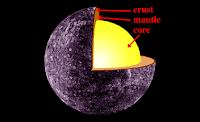
The morning sky this month is spectacular. And I know someone who is up that time on his way to school. And with the switch of daylight savings, it is still dark enough to see these events.
I've talked about Saturn (which you can still see in the evening sky looking east) and Venus (which you can still see looking west at about the same time). I mentioned that we probably wouldn't be here on earth if it were not for Jupiter blocking a lot of space junk that might get hurled into our blue planet.
And if you look southeast in the morning, you can see Jupiter. But here is something else exciting in that early sky: Mercury and Mars.
 Mercury is in the southeast when Jupiter is at its brightest. Look just over the horizon and when you find Jupiter, look to the lower left and you should be able to see Mercury. At 51 million miles from Earth, it is the closest planet to the sun.
Mercury is in the southeast when Jupiter is at its brightest. Look just over the horizon and when you find Jupiter, look to the lower left and you should be able to see Mercury. At 51 million miles from Earth, it is the closest planet to the sun.Even more fun, it is about to be orbited again by Messenger. On its 4.9 billion-mile journey to becoming the first spacecraft to orbit the planet Mercury, MESSENGER has flown by Earth once, Venus twice, and Mercury twice. Still to come is one more flyby of Mercury in late September 2009.
And even though Mercury is really close to the sun, it actually has water ice at the bottom of deep craters where the sun never shines. Mercury looks a lot like the moon but it has no moons of its own. It does have an atmosphere but because it is so close to the sun, the solar winds whip it out into space.

It would be hard to figure out what clothes to bring if you ever went there. The temperatures range from 450 degrees Celsius (840 degrees F) during the day as low as -170 degrees C (-275 degrees F) at night! Hotter than Venus and then colder than cold.
You have to look really close because the sun can be just bright enough to make it hard to see.
Tomorrow: Mars
No comments:
Post a Comment